Epson EB-X10, EB-S9, EB-W9, EB-S92, EB-X92 User Manual
...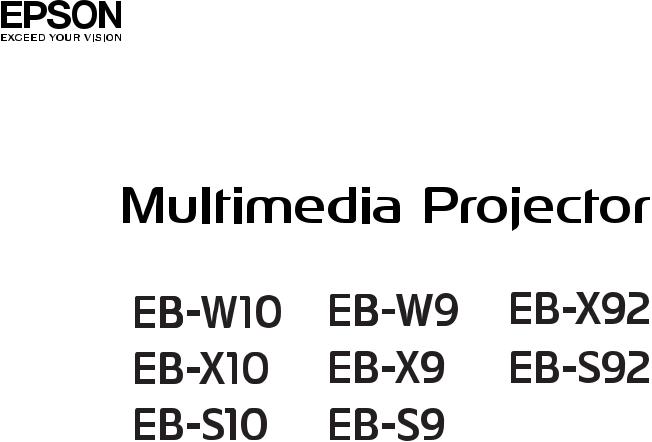
User's Guide

Notations Used in This Guide
•Safety indications
The documentation and the projector use graphical symbols to show how to use the projector safely.
The indications and their meaning are as follows. Make sure you understand them properly before reading the guide.
|
|
Warning |
This symbol indicates information that, if ignored, could possibly result in personal injury or even death due to incorrect handling. |
|
|
|
|
|
|
|
|
Caution |
This symbol indicates information that, if ignored, could possibly result in personal injury or physical damage due to incorrect handling. |
|
|
|
|
|
|
• General information indications |
|
|||
|
|
|
|
|
|
|
Attention |
Indicates procedures which may result in damage or injury if sufficient care is not taken. |
|
|
|
|
|
|
|
|
q |
Indicates additional information and points which may be useful to know regarding a topic. |
|
|
|
|
|
|
|
|
|
|
|
|
|
s |
Indicates a page where detailed information regarding a topic can be found. |
|
|
|
|
|
|
|
|
g |
Indicates that an explanation of the underlined word or words in front of this symbol appears in the glossary of terms. See the "Glossary" |
|
|
|
|
|
section of the "Appendix". s p.102 |
|
|
|
|
|
|
|
|
|
Indicates operating methods and the order of operations. |
|
|
Procedure |
|
|
|
|
|
|
The procedure indicated should be carried out in the order of the numbered steps. |
|
|
[ (Name) ] |
Indicates the name of the buttons on the Remote Control or the Control panel. |
|
|
|
|
|
Example: [Esc] button |
|
|
|
||
|
"(Menu Name)" |
Indicates Configuration Menu items. |
||
|
Brightness (bolded) |
Example: |
||
|
|
|
|
Select "Brightness" from the Image menu. |
|
|
|
|
Image menu - Brightness |
|
|
|
|
|

Contents |
|
3 |
|
|
|
Notations Used in This Guide . . . . . . . . . . . . . . . . . . . . . . . . 2
Introduction
Projector Features . . . . . . . . . . . . . . . . . . . . . . . . . . . . . . . . . . . . . . . . . . 7
Easy to handle and compact . . . . . . . . . . . . . . . . . . . . . . . . . . . . . . . . . . . . . . . 7 Compact and lightweight . . . . . . . . . . . . . . . . . . . . . . . . . . . . . . . . . . . . . . . 7 Connecting with a USB cable and Projecting (USB Display) . . . . . . . . . . . . . . . . 7 The A/V mute slide makes it easy to project and store . . . . . . . . . . . . . . . . . . . . 7
A single foot design means you do not have to make any difficult leveling adjustments . . . . . . . . . . . . . . . . . . . . . . . . . . . . . . . . . . . . . . . . . . . . . . . . 7
Front air exhaust vents . . . . . . . . . . . . . . . . . . . . . . . . . . . . . . . . . . . . . . . . . 7 Direct power On/Off . . . . . . . . . . . . . . . . . . . . . . . . . . . . . . . . . . . . . . . . . . 7 No cool down delay . . . . . . . . . . . . . . . . . . . . . . . . . . . . . . . . . . . . . . . . . . . 7 Enhanced security functions . . . . . . . . . . . . . . . . . . . . . . . . . . . . . . . . . . . . . . . 8 Password Protect to restrict and manage users . . . . . . . . . . . . . . . . . . . . . . . . 8 Control Panel Lock restricts button operation on the Control panel . . . . . . . . . . 8 EB-W10/X10 Features . . . . . . . . . . . . . . . . . . . . . . . . . . . . . . . . . . . . . . . . . . . . 8
Projecting JPEG images on a USB storage or a digital camera without using a computer . . . . . . . . . . . . . . . . . . . . . . . . . . . . . . . . . . . . . . . . . . . . . . . . . . 8
Equipped with HDMI port for a wide range of usage, such as watching movies and videos . . . . . . . . . . . . . . . . . . . . . . . . . . . . . . . . . . . . . . . . . . . . . . . . . . . . 8
Part Names and Functions . . . . . . . . . . . . . . . . . . . . . . . . . . . . . . . . . . . 9
Front/Top . . . . . . . . . . . . . . . . . . . . . . . . . . . . . . . . . . . . . . . . . . . . . . . . . . . 9
Rear (EB-W10/X10) . . . . . . . . . . . . . . . . . . . . . . . . . . . . . . . . . . . . . . . . . . . . . 10
Rear (EB-S10) . . . . . . . . . . . . . . . . . . . . . . . . . . . . . . . . . . . . . . . . . . . . . . . . 11
Rear (EB-W9/X9/S9/X92/S92) . . . . . . . . . . . . . . . . . . . . . . . . . . . . . . . . . . . . . . 12
Base . . . . . . . . . . . . . . . . . . . . . . . . . . . . . . . . . . . . . . . . . . . . . . . . . . . . . . 13
Control Panel (EB-W10/X10/W9/X9/X92) . . . . . . . . . . . . . . . . . . . . . . . . . . . . . . 13
Control Panel (EB-S10/S9/S92) . . . . . . . . . . . . . . . . . . . . . . . . . . . . . . . . . . . . . 14
Remote Control . . . . . . . . . . . . . . . . . . . . . . . . . . . . . . . . . . . . . . . . . . . . . . . 15
Useful Functions
Connecting with a USB cable and Projecting (USB Display) . . . . 18
System Requirements . . . . . . . . . . . . . . . . . . . . . . . . . . . . . . . . . . . . . . . . . . 18
Connecting . . . . . . . . . . . . . . . . . . . . . . . . . . . . . . . . . . . . . . . . . . . . . . . . . 18
Connecting for the first time . . . . . . . . . . . . . . . . . . . . . . . . . . . . . . . . . . . . 20
From the second time . . . . . . . . . . . . . . . . . . . . . . . . . . . . . . . . . . . . . . . . 21
Uninstalling . . . . . . . . . . . . . . . . . . . . . . . . . . . . . . . . . . . . . . . . . . . . . . . 21
Changing the Projected Image . . . . . . . . . . . . . . . . . . . . . . . . . . . . . . 22
Automatically Detect Input Signal and Change the Projected Image (Source Search)
. . . . . . . . . . . . . . . . . . . . . . . . . . . . . . . . . . . . . . . . . . . . . . . . . . . . . . . . . . 22 Switch to the target image by Remote Control . . . . . . . . . . . . . . . . . . . . . . . . . . 23
Functions for Enhancing Projection . . . . . . . . . . . . . . . . . . . . . . . . . 24
Selecting the Projection Quality (Selecting Color Mode) . . . . . . . . . . . . . . . . . . . 24 Setting the Auto Iris . . . . . . . . . . . . . . . . . . . . . . . . . . . . . . . . . . . . . . . . . . . . 25 Hiding the Image and Sound Temporarily (A/V Mute) . . . . . . . . . . . . . . . . . . . . . 25 Freezing the Image (Freeze) . . . . . . . . . . . . . . . . . . . . . . . . . . . . . . . . . . . . . . 26 Changing the Aspect Ratio . . . . . . . . . . . . . . . . . . . . . . . . . . . . . . . . . . . . . . . 27
Changing methods . . . . . . . . . . . . . . . . . . . . . . . . . . . . . . . . . . . . . . . . . . 27 Changing the aspect ratio for video equipment images . . . . . . . . . . . . . . . . . . 28
Changing the aspect ratio for computer images (EB-X10/S10/X9/S9/X92/S92)
. . . . . . . . . . . . . . . . . . . . . . . . . . . . . . . . . . . . . . . . . . . . . . . . . . . . . . . . 29 Changing the aspect ratio for computer images (EB-W10/W9) . . . . . . . . . . . . . 30 Pointer Function (Pointer) . . . . . . . . . . . . . . . . . . . . . . . . . . . . . . . . . . . . . . . . 32 Enlarging Part of the Image (E-Zoom) . . . . . . . . . . . . . . . . . . . . . . . . . . . . . . . . 33 Using the Remote Control as a Mouse . . . . . . . . . . . . . . . . . . . . . . . . . . . . . . . . 34 Wireless Mouse . . . . . . . . . . . . . . . . . . . . . . . . . . . . . . . . . . . . . . . . . . . . . 34 Page Up/Down . . . . . . . . . . . . . . . . . . . . . . . . . . . . . . . . . . . . . . . . . . . . . 36
Security Functions . . . . . . . . . . . . . . . . . . . . . . . . . . . . . . . . . . . . . . . . . 37
Managing Users (Password Protect) . . . . . . . . . . . . . . . . . . . . . . . . . . . . . . . . . 37 Type of Password Protect . . . . . . . . . . . . . . . . . . . . . . . . . . . . . . . . . . . . . . 37 Setting Password Protect . . . . . . . . . . . . . . . . . . . . . . . . . . . . . . . . . . . . . . 37 Entering the Password . . . . . . . . . . . . . . . . . . . . . . . . . . . . . . . . . . . . . . . . 38 Restricting Operation (Control Panel Lock) . . . . . . . . . . . . . . . . . . . . . . . . . . . . 39 Anti-Theft Lock . . . . . . . . . . . . . . . . . . . . . . . . . . . . . . . . . . . . . . . . . . . . . . . 40

Contents |
|
4 |
|
|
|
Installing the wire lock . . . . . . . . . . . . . . . . . . . . . . . . . . . . . . . . . . . . . . . . 40
Making a Presentation with a Slideshow (EB-W10/X10 only)
. . . . . . . . . . . . . . . . . . . . . . . . . . . . . . . . . . . . . . . . . . . . . . . . . . . . . . . . . . . 41
Specifications of Files that can be Projected in a Slideshow . . . . . . . . . . . . . . . . . 41 Connecting and Removing USB Devices . . . . . . . . . . . . . . . . . . . . . . . . . . . . . . 41 Connecting USB devices . . . . . . . . . . . . . . . . . . . . . . . . . . . . . . . . . . . . . . . 41 Removing USB devices . . . . . . . . . . . . . . . . . . . . . . . . . . . . . . . . . . . . . . . . 42 Starting and Ending a Slideshow . . . . . . . . . . . . . . . . . . . . . . . . . . . . . . . . . . . 42 Starting a slideshow . . . . . . . . . . . . . . . . . . . . . . . . . . . . . . . . . . . . . . . . . . 42 Ending a slideshow . . . . . . . . . . . . . . . . . . . . . . . . . . . . . . . . . . . . . . . . . . 42 Slideshow Basic Operations . . . . . . . . . . . . . . . . . . . . . . . . . . . . . . . . . . . . . . 42 Rotating Images . . . . . . . . . . . . . . . . . . . . . . . . . . . . . . . . . . . . . . . . . . . . . . 43 Projecting Image Files . . . . . . . . . . . . . . . . . . . . . . . . . . . . . . . . . . . . . . . . . . 44 Projecting an image . . . . . . . . . . . . . . . . . . . . . . . . . . . . . . . . . . . . . . . . . . 44 Sequentially projecting all image files in a folder (Slideshow) . . . . . . . . . . . . . . 45 Image File Display Setting and Slideshow Operation Setting . . . . . . . . . . . . . . . . 46
Configuration Menu
Using the Configuration Menu . . . . . . . . . . . . . . . . . . . . . . . . . . . . . . 48
List of Functions . . . . . . . . . . . . . . . . . . . . . . . . . . . . . . . . . . . . . . . . . . . 49
Image Menu . . . . . . . . . . . . . . . . . . . . . . . . . . . . . . . . . . . . . . . . . . . . . . . . . |
49 |
Signal Menu . . . . . . . . . . . . . . . . . . . . . . . . . . . . . . . . . . . . . . . . . . . . . . . . . |
50 |
Settings Menu . . . . . . . . . . . . . . . . . . . . . . . . . . . . . . . . . . . . . . . . . . . . . . . . |
52 |
Extended Menu . . . . . . . . . . . . . . . . . . . . . . . . . . . . . . . . . . . . . . . . . . . . . . . |
53 |
Info Menu (Display Only) . . . . . . . . . . . . . . . . . . . . . . . . . . . . . . . . . . . . . . . . |
55 |
Reset Menu . . . . . . . . . . . . . . . . . . . . . . . . . . . . . . . . . . . . . . . . . . . . . . . . . |
56 |
Troubleshooting
Using the Help . . . . . . . . . . . . . . . . . . . . . . . . . . . . . . . . . . . . . . . . . . . . . 58
Problem Solving . . . . . . . . . . . . . . . . . . . . . . . . . . . . . . . . . . . . . . . . . . . 59
t Indicator is lit or flashing red . . . . . . . . . . . . . . . . . . . . . . . . . . . . . . . . . . 60 moIndicators are flashing or lit orange . . . . . . . . . . . . . . . . . . . . . . . . . . . . 61 When the Indicators Provide No Help . . . . . . . . . . . . . . . . . . . . . . . . . . . . . . . . 62 Problems relating to projection . . . . . . . . . . . . . . . . . . . . . . . . . . . . . . . . . . 63 Problems relating to USB Display . . . . . . . . . . . . . . . . . . . . . . . . . . . . . . . . . 68 Other problems . . . . . . . . . . . . . . . . . . . . . . . . . . . . . . . . . . . . . . . . . . . . . 69
Appendix
Installation Methods . . . . . . . . . . . . . . . . . . . . . . . . . . . . . . . . . . . . . . . 71
Cleaning . . . . . . . . . . . . . . . . . . . . . . . . . . . . . . . . . . . . . . . . . . . . . . . . . . 72
Cleaning the Projector's Surface . . . . . . . . . . . . . . . . . . . . . . . . . . . . . . . . . . . 72 Cleaning the Lens . . . . . . . . . . . . . . . . . . . . . . . . . . . . . . . . . . . . . . . . . . . . . 72 Cleaning the Air Filter . . . . . . . . . . . . . . . . . . . . . . . . . . . . . . . . . . . . . . . . . . . 73
Replacing Consumables . . . . . . . . . . . . . . . . . . . . . . . . . . . . . . . . . . . . 74
Replacing the Remote Control Batteries . . . . . . . . . . . . . . . . . . . . . . . . . . . . . . 74 Replacing the Lamp . . . . . . . . . . . . . . . . . . . . . . . . . . . . . . . . . . . . . . . . . . . . 75 Lamp replacement period . . . . . . . . . . . . . . . . . . . . . . . . . . . . . . . . . . . . . . 75 How to replace the lamp . . . . . . . . . . . . . . . . . . . . . . . . . . . . . . . . . . . . . . 75 Resetting the lamp hours . . . . . . . . . . . . . . . . . . . . . . . . . . . . . . . . . . . . . . 78 Replacing the Air Filter . . . . . . . . . . . . . . . . . . . . . . . . . . . . . . . . . . . . . . . . . . 78 Air filter replacement period . . . . . . . . . . . . . . . . . . . . . . . . . . . . . . . . . . . . 78 How to replace the air filter . . . . . . . . . . . . . . . . . . . . . . . . . . . . . . . . . . . . . 78
Optional Accessories and Consumables . . . . . . . . . . . . . . . . . . . . . . 80
Optional accessories . . . . . . . . . . . . . . . . . . . . . . . . . . . . . . . . . . . . . . . . . . . 80 Consumables . . . . . . . . . . . . . . . . . . . . . . . . . . . . . . . . . . . . . . . . . . . . . . . . 80
Saving a User's Logo . . . . . . . . . . . . . . . . . . . . . . . . . . . . . . . . . . . . . . . 81
Screen Size and Projection Distance . . . . . . . . . . . . . . . . . . . . . . . . . 83
Projection Distances (EB-W10/W9) . . . . . . . . . . . . . . . . . . . . . . . . . . . . . . . . . . 83
Projection Distances (EB-X10/X9/X92) . . . . . . . . . . . . . . . . . . . . . . . . . . . . . . . . 84
Projection Distances (EB-S10/S9/S92) . . . . . . . . . . . . . . . . . . . . . . . . . . . . . . . . 85
Reading the Indicators . . . . . . . . . . . . . . . . . . . . . . . . . . . . . . . . . . . . . . . . . . 59

Contents |
|
5 |
|
|
|
Connecting to External Equipment . . . . . . . . . . . . . . . . . . . . . . . . . . 86
Connecting to an external monitor (EB-W9/X9/S9 only) . . . . . . . . . . . . . . . . . . . . 86 Connecting to External Speakers (EB-S10/W9/X9/S9/X92/S92 only) . . . . . . . . . . . . 87
Monitoring and Controlling the Projector Using a Computer
(ESC/VP21 Commands) . . . . . . . . . . . . . . . . . . . . . . . . . . . . . . . . . . . . . 88
Before You Begin . . . . . . . . . . . . . . . . . . . . . . . . . . . . . . . . . . . . . . . . . . . . . . 88
Command List . . . . . . . . . . . . . . . . . . . . . . . . . . . . . . . . . . . . . . . . . . . . . . . . 88
Communications protocol . . . . . . . . . . . . . . . . . . . . . . . . . . . . . . . . . . . . . 89
Supported Monitor Displays . . . . . . . . . . . . . . . . . . . . . . . . . . . . . . . . 90
Supported Monitor Displays (EB-W10/W9) . . . . . . . . . . . . . . . . . . . . . . . . . . . . . 90 Computer signals (analog RGB) . . . . . . . . . . . . . . . . . . . . . . . . . . . . . . . . . . 90 Component Video . . . . . . . . . . . . . . . . . . . . . . . . . . . . . . . . . . . . . . . . . . . 91 Composite video/S-video . . . . . . . . . . . . . . . . . . . . . . . . . . . . . . . . . . . . . . 91 Input signal from the HDMI port (EB-W10 only) . . . . . . . . . . . . . . . . . . . . . . . 91
Supported Monitor Displays (EB-X10/X9/X92) . . . . . . . . . . . . . . . . . . . . . . . . . . 92 Computer signals (analog RGB) . . . . . . . . . . . . . . . . . . . . . . . . . . . . . . . . . . 92 Component Video . . . . . . . . . . . . . . . . . . . . . . . . . . . . . . . . . . . . . . . . . . . 93 Composite video/S-video . . . . . . . . . . . . . . . . . . . . . . . . . . . . . . . . . . . . . . 94 Input signal from the HDMI port (EB-X10 only) . . . . . . . . . . . . . . . . . . . . . . . . 94
Supported Monitor Displays (EB-S10/S9/S92) . . . . . . . . . . . . . . . . . . . . . . . . . . . 95 Computer signals (analog RGB) . . . . . . . . . . . . . . . . . . . . . . . . . . . . . . . . . . 95 Component Video . . . . . . . . . . . . . . . . . . . . . . . . . . . . . . . . . . . . . . . . . . . 96 Composite video/S-video . . . . . . . . . . . . . . . . . . . . . . . . . . . . . . . . . . . . . . 96
Specifications . . . . . . . . . . . . . . . . . . . . . . . . . . . . . . . . . . . . . . . . . . . . . 97
Projector General Specifications . . . . . . . . . . . . . . . . . . . . . . . . . . . . . . . . . . . 97
Appearance . . . . . . . . . . . . . . . . . . . . . . . . . . . . . . . . . . . . . . . . . . . . . . 101
Glossary . . . . . . . . . . . . . . . . . . . . . . . . . . . . . . . . . . . . . . . . . . . . . . . . . 102
General Notes . . . . . . . . . . . . . . . . . . . . . . . . . . . . . . . . . . . . . . . . . . . . 104
About Notations . . . . . . . . . . . . . . . . . . . . . . . . . . . . . . . . . . . . . . . . . . . . . |
104 |
General Notice: . . . . . . . . . . . . . . . . . . . . . . . . . . . . . . . . . . . . . . . . . . . . . . |
104 |
Index . . . . . . . . . . . . . . . . . . . . . . . . . . . . . . . . . . . . . . . . . . . . . . . . . . . . 105

Introduction
This chapter explains the projector's features and the part names.
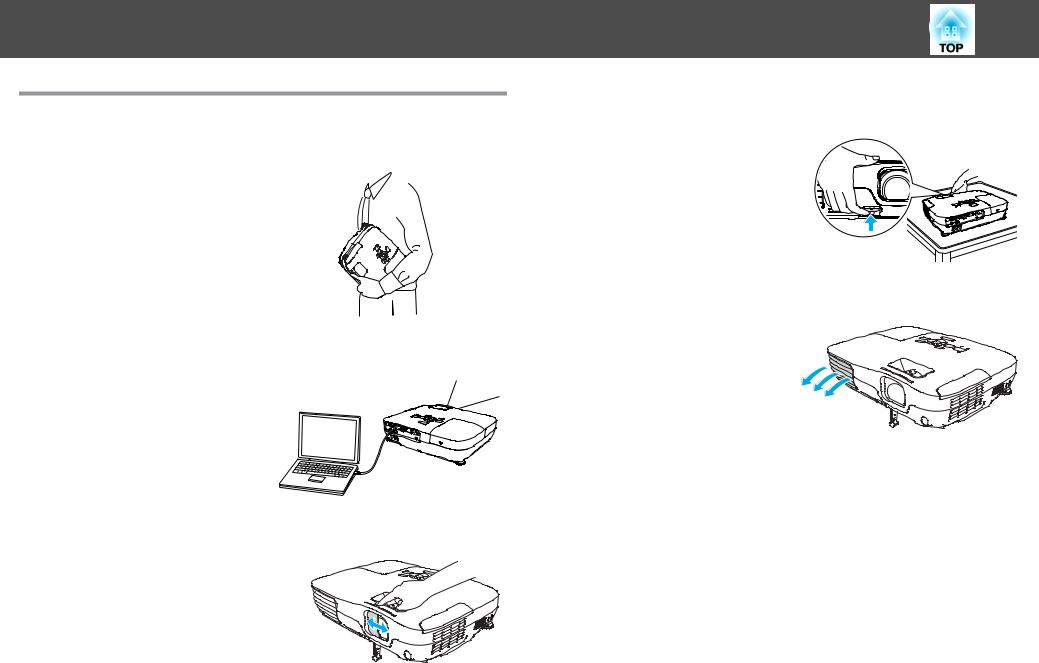
Projector Features
Easy to handle and compact
Compact and lightweight
Its light and compact body makes it easy to carry.
Connecting with a USB cable and Projecting (USB Display)
Simply by connecting the projector to a computer with a USB cable, you can project images from the computer screen. Compatible with both Windows and Mac OS. s p.18
The A/V mute slide makes it easy to project and store
You can stop and resume projection easily by opening and closing the A/V mute slide which makes giving clear presentations easier.
7
A single foot design means you do not have to make any difficult leveling adjustments
You can easily make height adjustments with one hand.
Front air exhaust vents
The front air exhaust vents direct hot air away from the presenter and computer equipment.
Direct power On/Off
In places where power is managed centrally, such as in a conference room, the projector can be set to power on and off automatically when the power source to which the projector is connected is switched on or off.
No cool down delay
After turning the projector's power off, you can disconnect the projector's power cable without having to wait for the projector to cool down.
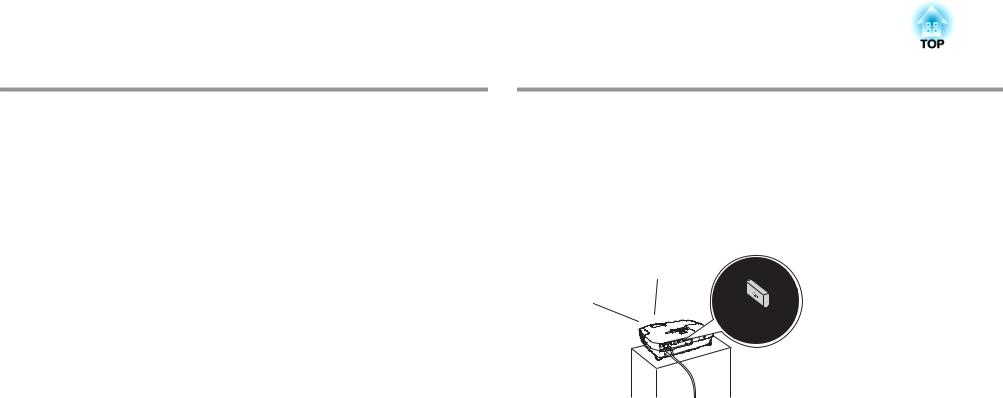
Projector Features |
|
8 |
|
|
|
Enhanced security functions
Password Protect to restrict and manage users
By setting a Password you can restrict who can use the projector. s p.37
Control Panel Lock restricts button operation on the Control panel
You can use this to prevent people changing projector settings without permission at events, in schools, and so on. s p.39
EB-W10/X10 Features
Projecting JPEG images on a USB storage or a digital camera without using a computer
By connecting a USB storage or a digital camera to the projector, you can project a Slideshow of JPEG images, such as pictures taken with a digital camera. Images can be projected quickly and easily, with no need to connect a computer. s p.41
Equipped with HDMI port for a wide range of usage, such as watching movies and videos
You can project high-quality images and music by connecting various digital RGB equipment to the HDMI port, such as a DVD player, Blu-ray disc player, game console, and needless to mention, a computer.
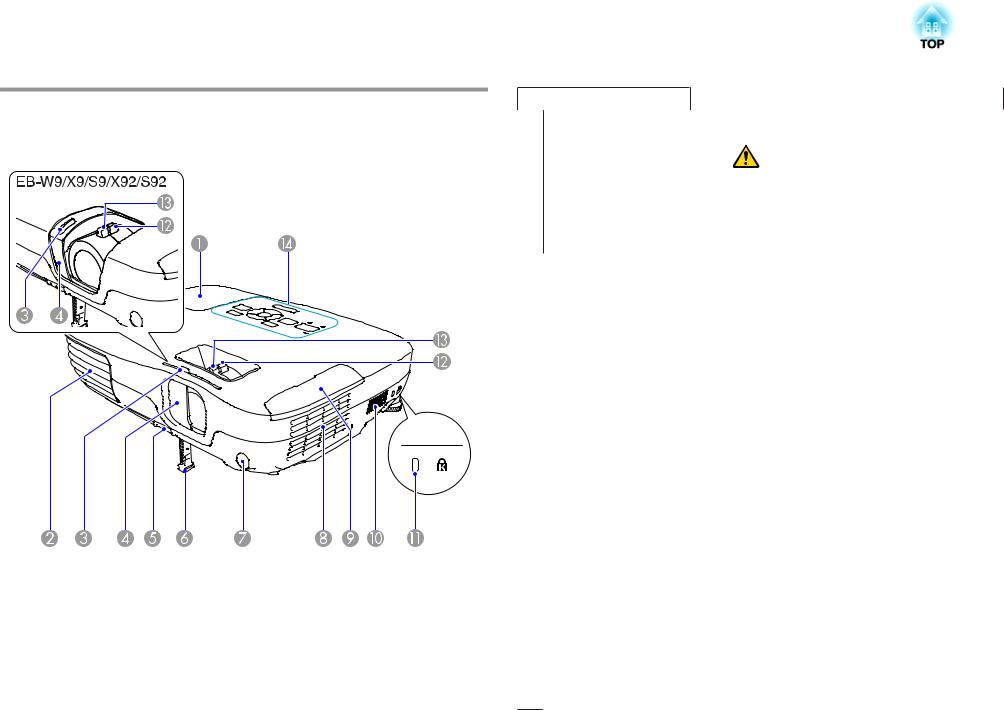
Part Names and Functions |
|
9 |
|
|
|
Front/Top
The illustration is that of EB-W10/X10. From here on, all features will be explained using illustrations of EB-W10/X10 unless otherwise mentioned.
|
Name |
Function |
A |
Lamp cover |
Open this cover when replacing the projector's Lamp. |
|
|
s p.75 |
|
|
|
Name |
Function |
B Air exhaust vent |
Exhaust vent for air used to cool the projector internally. |
|
|
Caution |
|
|
|
Do not place objects that may become warped or |
|
|
|
otherwise affected by heat near the Air exhaust vent |
|
|
|
and do not put your face or hands near the vent |
|
|
|
while projection is in progress. |
|
|
|
|
|
|
|
|
|
C A/V mute slide knob |
Slide the knob to open and close the A/V mute slide. |
|
|
|
|
|
|
D A/V mute slide |
Close when not using the projector to protect the lens. By |
|
|
|
closing during projection you can hide the image and the |
|
|
|
sound (A/V Mute). s p.25 |
|
|
|
|
|
|
E Foot adjust lever |
Pull the Foot adjust lever to extend and retract the Front |
|
|
|
adjustable foot. s Quick Start Guide |
|
|
|
|
|
|
F Front adjustable foot |
Extend and adjust the position of the projected image |
|
|
|
when the projector is placed on a surface such as a desk. |
|
|
|
s Quick Start Guide |
|
|
|
|
|
|
G Remote Receiver |
Receives signals from the remote control. s Quick Start |
|
|
|
Guide |
|
|
|
|
|
|
H Air filter |
Takes in air to cool the projector internally. If dust collects |
|
|
(Air intake vent) |
here it can cause the internal temperature to rise, and this |
|
|
|
can lead to problems with operation and shorten the |
|
|
|
optical engine's service life. Be sure to clean the Air filter |
|
|
|
regularly. s p.73, p.78 |
|
|
|
|
|
|
I Air filter cover |
Open and close when replacing the air filter. s p.78 |
|
|
|
|
|
|
J Speaker |
|
|
|
|
|
|
|
K Security slot |
The Security slot is compatible with the Microsaver |
|
|
|
Security System manufactured by Kensington. |
|
|
|
s p.40 |
|
|
|
|
|
|
L Zoom ring |
Adjusts the image size. s Quick Start Guide |
|
|
(EB-W10/X10/W9/X9/ |
|
|
|
X92 only) |
|
|
|
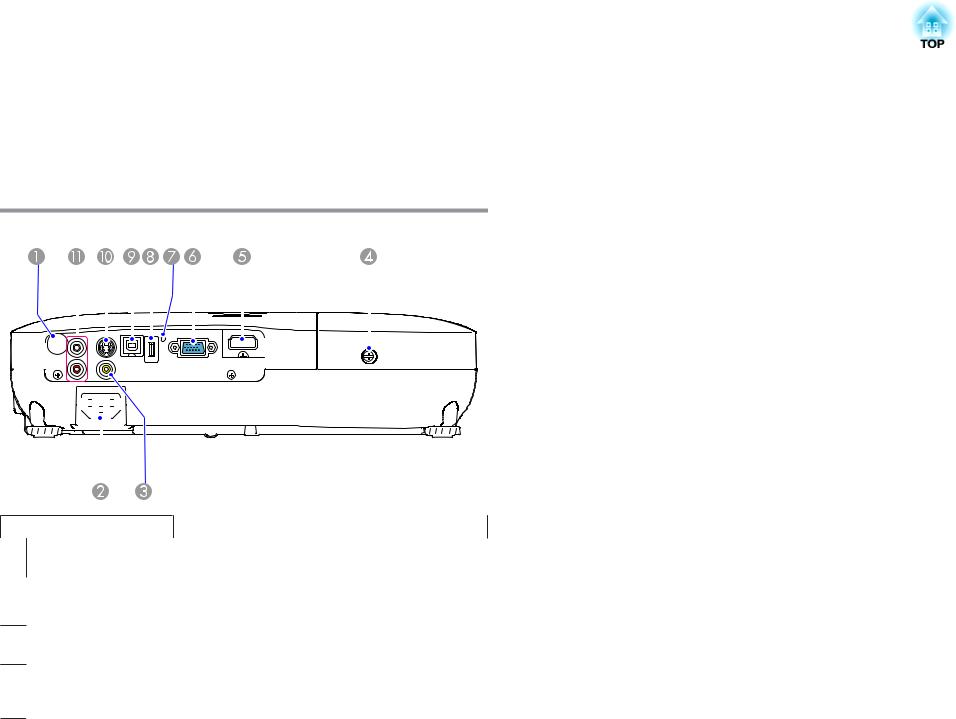
Part Names and Functions |
|
10 |
|
|
|
|
Name |
Function |
M |
Focus ring |
Adjusts the image focus. s Quick Start Guide |
|
|
|
N |
Control panel |
s "Control Panel (EB-W10/X10/W9/X9/X92)" p.13 |
|
|
s "Control Panel (EB-S10/S9/S92)" p.14 |
|
|
|
Rear (EB-W10/X10)
|
|
|
|
|
|
|
|
|
|
|
|
|
|
|
|
|
|
|
|
|
|
|
|
|
|
|
|
|
|
|
|
|
|
|
|
|
|
|
|
|
|
|
|
|
|
|
|
|
|
|
|
|
|
|
|
|
|
|
|
|
|
|
|
|
|
|
|
|
|
|
|
|
|
|
|
|
|
|
|
|
|
|
|
|
|
|
|
|
|
|
|
|
|
|
|
|
|
|
|
|
|
|
|
|
|
|
|
|
|
|
|
|
|
|
|
|
|
|
|
|
|
|
|
|
|
|
|
|
|
|
|
|
|
|
|
|
|
|
|
|
|
|
|
|
|
|
|
|
|
|
|
|
|
|
|
|
|
|
|
|
|
|
|
|
|
|
|
|
|
|
|
|
|
|
|
|
|
|
|
|
|
|
|
|
|
|
|
|
|
|
|
|
|
|
|
|
|
|
|
|
|
|
|
|
|
|
|
|
|
|
|
|
|
|
|
|
|
|
|
|
|
|
|
|
|
|
|
|
|
|
|
|
|
|
|
|
|
|
|
|
|
|
|
|
|
|
|
|
|
|
|
|
|
|
|
|
|
|
|
|
|
|
|
|
|
|
|
|
|
|
|
|
|
|
|
|
|
|
|
|
|
|
|
|
|
|
|
|
|
|
|
|
|
|
|
|
|
|
|
|
|
|
|
|
|
|
|
|
|
|
|
|
|
|
|
|
|
|
|
|
|
|
|
|
|
|
|
|
|
|
|
|
|
|
|
|
|
|
|
|
|
|
|
|
|
|
|
|
|
|
|
|
|
|
|
|
|
|
|
|
|
|
|
|
|
|
|
|
|
|
|
|
|
|
|
|
|
|
|
|
|
|
|
|
|
|
|
|
|
|
|
|
|
|
|
|
|
|
|
|
|
|
|
|
|
|
|
|
|
|
|
|
|
|
|
|
|
|
|
|
|
|
|
|
|
|
|
|
|
|
|
|
|
|
|
|
|
|
|
|
|
|
|
|
|
|
|
|
|
|
|
|
|
|
|
|
|
|
|
|
|
|
|
|
|
|
|
|
|
|
|
|
|
|
|
|
|
|
|
|
|
|
|
|
|
|
|
|
|
|
|
|
|
|
|
|
|
|
|
|
|
|
|
|
|
|
|
|
|
|
|
|
|
|
|
|
|
|
|
|
|
|
|
|
|
|
|
|
|
|
|
|
|
|
|
|
|
|
|
|
|
|
|
|
|
|
|
|
|
|
|
|
|
|
|
|
|
|
|
|
|
|
|
|
|
|
|
|
|
|
|
|
|
|
|
|
|
|
|
|
|
|
|
|
|
|
|
|
|
|
|
|
|
|
Name |
|
|
|
|
|
|
|
Function |
||||||||||||||||||||
A Remote Receiver |
|
|
Receives signals from the remote control. s Quick Start |
|||||||||||||||||||||||||||||||||||
|
|
|
|
|
|
|
|
|
|
|
|
|
|
|
|
|
|
|
|
|
|
|
|
|
|
Guide |
||||||||||||
|
|
|
|
|
|
|
|
|
|
|
|
|
|
|
|
|
|
|
|
|
|
|
|
|
|
|
|
|
|
|
|
|
|
|||||
B Power inlet |
|
|
Connects to the power cable. s Quick Start Guide |
|||||||||||||||||||||||||||||||||||
|
|
|
|
|
|
|
|
|
|
|
|
|
|
|
|
|
|
|
|
|
|
|
|
|
|
|
|
|
|
|
|
|
|
|||||
C Video Input Port |
|
|
For composite video signals from video sources. |
|||||||||||||||||||||||||||||||||||
DLamp Cover Fixing Screw to fix the Lamp cover in place. s p.75
Screw
E HDMI port |
Inputs video signals from HDMI compatible video |
|
equipment and computers. This projector is compatible |
|
with HDCPg. |
|
Name |
Function |
F |
Computer input port |
For video signals from a computer and component video |
|
|
signals from other video sources. |
|
|
|
G |
USB indicator |
The following explains the status of USB devices |
|
|
connected to USB(TypeA) port. |
|
|
OFF: USB device is not connected |
|
|
Orange Light ON: USB device is connected |
|
|
Green Light ON: USB device is operating |
|
|
Red Light ON: Error |
|
|
|
H |
USB(TypeA) port |
Connects a USB storage device or a digital camera, and |
|
|
projects JPEG images using Slideshow. s p.41 |
|
|
|
I |
USB(TypeB) port |
You can use the following functions by connecting to a |
|
|
computer with the supplied USB cable. |
|
|
• USB Display s p.18 |
|
|
• Wireless Mouse s p.34 |
|
|
• Paging operation of document files such as PowerPoint |
|
|
files s p.36 |
|
|
• Monitoring and controlling of the projector via USB |
|
|
communication s p.88 |
|
|
|
J |
S-Video input port |
For S-video signals from video sources. |
|
|
|
K |
Audio-L/R port |
Inputs audio from the audio out port on the other |
|
|
equipment. s Quick Start Guide |
|
|
|
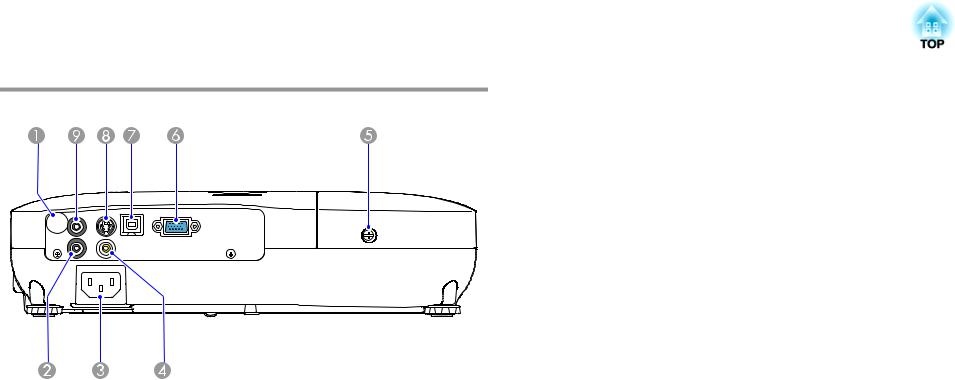
Part Names and Functions |
|
11 |
|
|
|
Rear (EB-S10)
|
Name |
Function |
A |
Remote Receiver |
Receives signals from the remote control. s Quick Start |
|
|
Guide |
|
|
|
B |
Audio port |
Inputs audio from the audio out port on the other |
|
|
equipment. s Quick Start Guide |
|
|
|
C |
Power inlet |
Connects to the power cable. s Quick Start Guide |
|
|
|
D |
Video Input Port |
For composite video signals from video sources. |
|
|
|
E |
Lamp Cover Fixing |
Screw to fix the Lamp cover in place. s p.75 |
|
Screw |
|
|
|
|
F |
Computer input port |
For video signals from a computer and component video |
|
|
signals from other video sources. |
|
|
|
|
Name |
Function |
G |
USB(TypeB) port |
You can use the following functions by connecting to a |
|
|
computer with the supplied USB cable. |
|
|
• USB Display s p.18 |
|
|
• Wireless Mouse s p.34 |
|
|
• Paging operation of document files such as PowerPoint |
|
|
files s p.36 |
|
|
• Monitoring and controlling of the projector via USB |
|
|
communication s p.88 |
|
|
|
H |
S-Video input port |
For S-video signals from video sources. |
|
|
|
I |
Audio Out port |
Outputs the sound of the image currently being projected |
|
|
to external speakers. s p.87 |
|
|
|
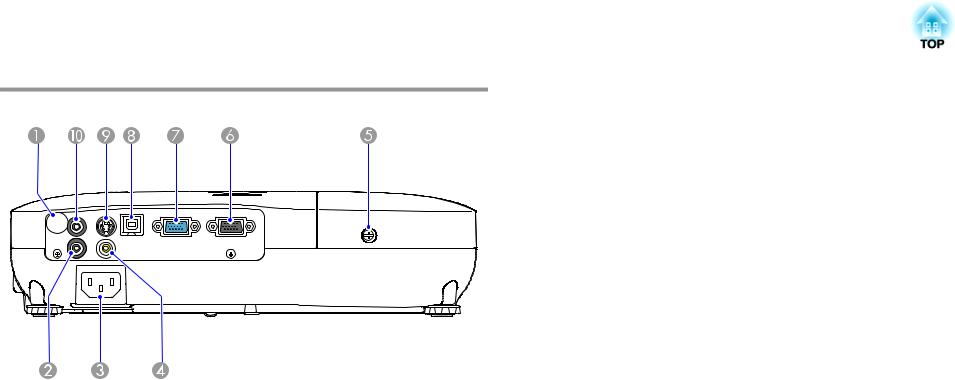
Part Names and Functions |
|
12 |
|
|
|
Rear (EB-W9/X9/S9/X92/S92)
|
Name |
Function |
A |
Remote Receiver |
Receives signals from the remote control. s Quick Start |
|
|
Guide |
|
|
|
B |
Audio port |
Inputs audio from the audio out port on the other |
|
|
equipment. s Quick Start Guide |
|
|
|
C |
Power inlet |
Connects to the power cable. s Quick Start Guide |
|
|
|
D |
Video Input Port |
For composite video signals from video sources. |
|
|
|
E |
Lamp Cover Fixing |
Screw to fix the Lamp cover in place. s p.75 |
|
Screw |
|
|
|
|
F |
Monitor Out port |
Outputs to an external monitor the image signal from the |
|
(EB-W9/X9/S9 only) |
computer connected to the Computer input port. This is |
|
|
not available for component video signals or other signals |
|
|
being input to any port other than the Computer input |
|
|
port. s p.86 |
|
|
|
G |
Computer input port |
For video signals from a computer and component video |
|
|
signals from other video sources. |
|
|
|
|
Name |
Function |
H |
USB(TypeB) port |
You can use the following functions by connecting to a |
|
|
computer with a USB cable. |
|
|
• USB Display s p.18 |
|
|
• Wireless Mouse s p.34 |
|
|
• Paging operation of document files such as PowerPoint |
|
|
files s p.36 |
|
|
• Monitoring and controlling of the projector via USB |
|
|
communication s p.88 |
|
|
|
I |
S-Video input port |
For S-video signals from video sources. |
|
|
|
J |
Audio Out port |
Outputs the sound of the image currently being projected |
|
|
to external speakers. s p.87 |
|
|
|
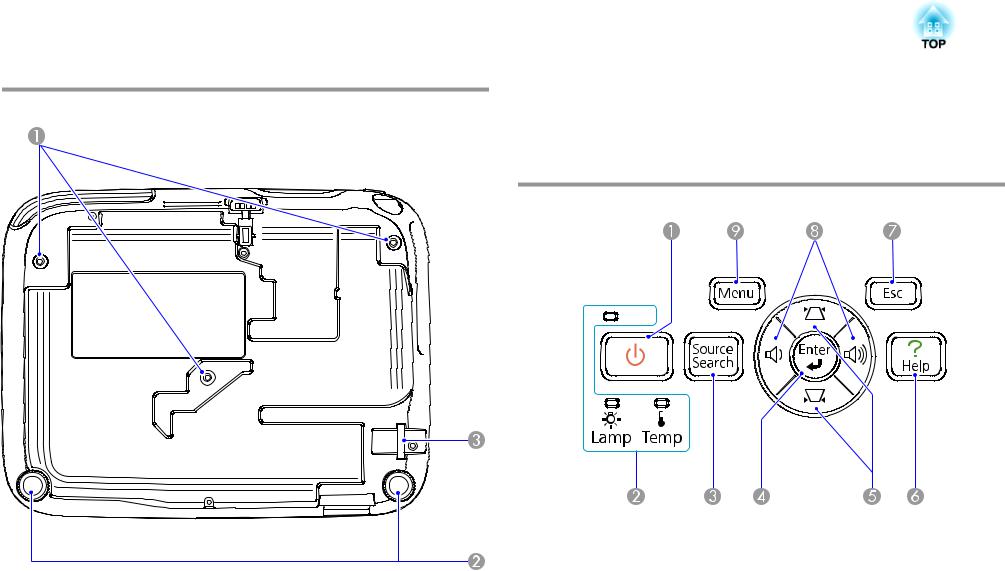
Part Names and Functions |
|
13 |
|
|
|
Base
|
Name |
Function |
C |
Security cable |
Pass a commercially available wire lock through here and |
|
installation point |
lock it in place. s p.40 |
|
|
|
Control Panel (EB-W10/X10/W9/X9/X92)
|
Name |
Function |
A |
Ceiling mount fixing |
Attach the optional Ceiling mount here when suspending |
|
points |
the projector from a ceiling. s p.71, p.80 |
|
(3 points) |
|
|
|
|
B |
Rear foot |
When setup on a desk, turn to extend and retract to adjust |
|
|
the horizontal tilt. s Quick Start Guide |
|
|
|
|
Name |
Function |
A |
[t] button |
Turns the projector power on or off. sQuick Start Guide |
|
|
|
B |
Status indicators |
The color of the indicators and whether they are flashing |
|
|
or lit indicate the status of the projector. s p.59 |
|
|
|
C |
[Source Search] |
Changes to the next input source that is connected to the |
|
button |
projector and is sending an image. s p.22 |
|
|
|
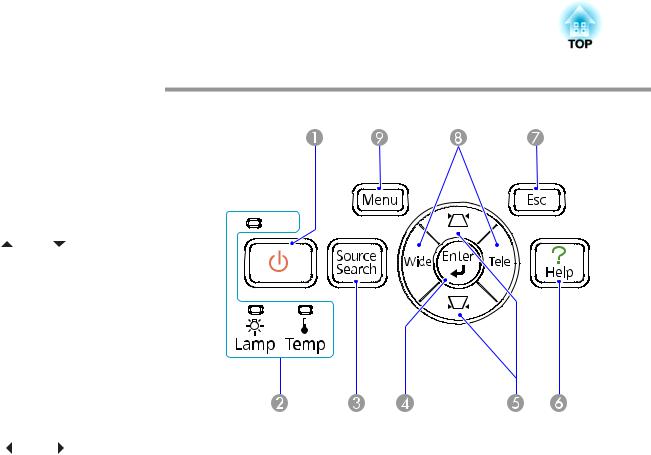
Part Names and Functions |
|
14 |
|
|
|
|
Name |
Function |
|
|
D |
[Enter] button |
If pressed during projection of computer signal images, it |
||
|
|
automatically adjusts the Tracking, Sync., and Position to |
||
|
|
project the optimum image. When a Configuration Menu |
||
|
|
or a Help screen is displayed, it accepts and enters the |
||
|
|
current selection and moves to the next level. |
|
|
|
|
|
||
E |
[w][v] button |
Corrects Keystone distortion. s Quick Start Guide |
||
|
|
However, when projecting in Slideshow (EB-W10/X10 |
||
|
|
only), the buttons only have the [ |
] and [ |
] functions. |
|
|
If pressed when a Configuration Menu or a Help screen is |
||
|
|
displayed, these buttons select menu items and setting |
||
|
|
values. s p.48 |
|
|
|
|
|
||
F |
[Help] button |
Displays and closes the Help screen which shows you how |
||
|
|
to deal with problems if they occur. s p.58 |
|
|
|
|
|
|
|
G |
[Esc] button |
Stops the current function. If pressed when a |
|
|
|
|
Configuration menu is displayed, it moves to the previous |
||
|
|
menu level. sp.48 |
|
|
|
|
|
|
|
H |
[a][b] button |
Adjusts the volume. s Quick Start Guide |
|
|
|
|
However, when projecting in Slideshow (EB-W10/X10 |
||
|
|
only), the buttons only have the [ |
] and [ |
] functions. |
|
|
If pressed when a Configuration Menu or a Help screen is |
||
|
|
displayed, these buttons select menu items and setting |
||
|
|
values. s p.48 |
|
|
|
|
|
||
I |
[Menu] button |
Displays and closes the Configuration Menu. s p.48 |
||
|
|
|
|
|
Control Panel (EB-S10/S9/S92)
|
Name |
Function |
A |
[t] button |
Turns the projector power on or off. sQuick Start Guide |
|
|
|
B |
Status indicators |
The color of the indicators and whether they are flashing |
|
|
or lit indicate the status of the projector. s p.59 |
|
|
|
C |
[Source Search] |
Changes to the next input source that is connected to the |
|
button |
projector and is sending an image. s p.22 |
|
|
|
D |
[Enter] button |
If pressed during projection of computer signal images, it |
|
|
automatically adjusts the Tracking, Sync., and Position to |
|
|
project the optimum image. When a Configuration Menu |
|
|
or a Help screen is displayed, it accepts and enters the |
|
|
current selection and moves to the next level. |
|
|
|
E |
[w][v] button |
Corrects Keystone distortion. s Quick Start Guide |
|
|
If pressed when a Configuration Menu or a Help screen is |
|
|
displayed, these buttons select menu items and setting |
|
|
values. s p.48 |
|
|
|
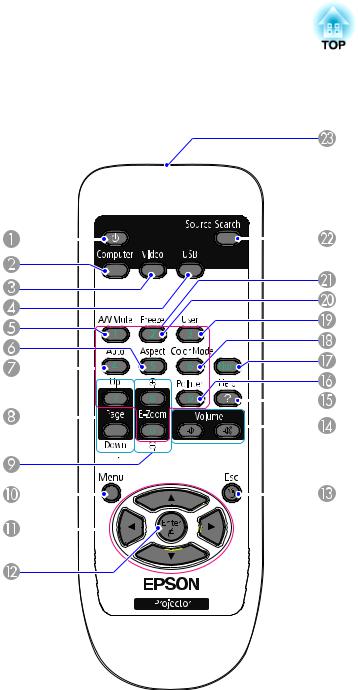
Part Names and Functions |
|
15 |
|
|
|
|
Name |
Function |
|
|
|
|
|
|
|
|
|
|
|
|
|
|
Remote Control |
||||||||||||||
F |
[Help] button |
Displays and closes the Help screen which shows you how |
|||||||||||||
|
|
|
|
|
|
|
|
|
|
|
|
||||
|
|
to deal with problems if they occur. s p.58 |
|
|
|
|
|
|
|
|
|
|
|
|
|
|
|
|
|
|
|
|
|
|
|
|
|
|
|
|
|
G |
[Esc] button |
Stops the current function. If pressed when a |
|
|
|
|
|
|
|
|
|
|
|
|
|
|
|
Configuration menu is displayed, it moves to the previous |
|
|
|
|
|
|
|
|
|
|
|
|
|
|
|
menu level. s p.48 |
|
|
|
|
|
|
|
|
|
|
|
|
|
|
|
|
|
|
|
|
|
|
|
|
|
|
|
|
|
H |
[Tele]/[Wide] buttons |
Adjusts the projection screen size. Pressing the [Tele] |
|
|
|
|
|
|
|
|
|
|
|
|
|
|
|
button reduces the projection screen size, and pressing the |
|
|
|
|
|
|
|
|
|
|
|
|
|
|
|
[Wide] button increases it. s Quick Start Guide |
|
|
|
|
|
|
|
|
|
|
|
|
|
|
|
If pressed when a Configuration Menu or a Help screen is |
|
|
|
|
|
|
|
|
|
|
|
|
|
|
|
displayed, these buttons select menu items and setting |
|
|
|
|
|
|
|
|
|
|
|
|
|
|
|
values. s p.48 |
|
|
|
|
|
|
|
|
|
|
|
|
|
|
|
|
|
|
|
|
|
|
|
|
|
|
|
|
|
I |
[Menu] button |
Displays and closes the Configuration Menu. s p.48 |
|
|
|
|
|
|
|
|
|
|
|
|
|
|
|
|
|
|
|
|
|
|
|
|
|
|
|
|
|
|
|
|
|
|
|
|
|
|
|
|
|
|
|
|
|
|
|
|
|
|
|
|
|
|
|
|
|
|
|
|
|
|
|
|
|
|
|
|
|
|
|
|
|
|
|
|
|
|
|
|
|
|
|
|
|
|
|
|
|
|
|
|
|
|
|
|
|
|
|
|
|
|
|
|
|
|
|
|
|
|
|
|
|
|
|
|
|
|
|
|
|
|
|
|
|
|
|
|
|
|
|
|
|
|
|
|
|
|
|
|
|
|
|
|
|
|
|
|
|
|
|
|
|
|
|
|
|
|
|
|
|
|
|
|
|
|
|
|
|
|
|
|
|
|
|
|
|
|
|
|
|
|
|
|
|
|
|
|
|

Part Names and Functions |
|
16 |
|
|
|
|
|
Name |
|
Function |
A |
[t] button |
|
Turns the projector power On or Off. s Quick Start |
|
|
|
|
|
Guide |
|
|
|
||
B |
[Computer] button |
Changes to images from the Computer input port. |
||
|
|
|
|
s p.23 |
|
|
|
|
|
C |
[Video] button |
|
Each time the button is pressed, the image cycles through |
|
|
|
|
|
the Video, S-Video, and HDMI (EB-W10/X10 only) input |
|
|
|
|
ports. s p.23 |
|
|
|
|
|
D |
[USB] button |
|
Each time the button is pressed, the image changes |
|
|
|
|
|
between USB Display and Slideshow (EB-W10/X10 only). |
|
|
|
|
s p.23 |
|
|
|
||
E |
[A/V Mute] button |
Turns the video and audio on or off. s p.25 |
||
|
|
|
|
|
F |
[Aspect] button |
|
The aspect ratio changes each time the button is pressed. |
|
|
|
|
|
s p.27 |
|
|
|
|
|
G |
[Auto] button |
|
If pressed during projection of computer signal images, it |
|
|
|
|
|
automatically adjusts the Tracking, Sync., and Position to |
|
|
|
|
project the optimum image. |
|
|
|
|
|
H |
[Page] buttons |
|
• When pressed while the projector is connected to a |
|
|
(Down) (Up) |
|
computer with a USB cable, you can page up and down |
|
|
|
|
|
on the screen. s p.36 |
|
|
|
|
• When projecting in Slideshow, pressing this button |
|
|
|
|
displays the previous/next screen.(EB-W10/X10 only) |
|
|
|
|
s p.44 |
|
|
|
||
I |
[E-Zoom] buttons |
(z) Enlarges the image without changing the projection |
||
|
(z)(x) |
|
size. |
|
|
|
|
|
(x) Reduces parts of images that have been enlarged using |
|
|
|
|
the z button. s p.33 |
|
|
|
|
|
J |
[Menu] button |
|
Displays and closes the Configuration Menu. s p.48 |
|
|
|
|
|
|
K |
[ |
][ |
] |
When a Configuration Menu or Help screen is displayed, |
|
[ ][ |
] button |
|
it selects menu items and setting values. s p.48 |
|
|
During Wireless Mouse function, the mouse pointer |
||
|
|
|
|
|
|
|
|
|
moves in the direction the button is pushed. s p.34 |
|
|
|
|
|
|
Name |
Function |
L |
[Enter] button |
When a Configuration Menu or a Help screen is displayed, |
|
|
it accepts and enters the current selection and moves to the |
|
|
next level. s p.48 |
|
|
Acts as a mouse's left button when using the Wireless |
|
|
Mouse function. s p.34 |
|
|
|
M |
[Esc] button |
Stops the current function. If pressed when a |
|
|
configuration menu is displayed, it moves to the previous |
|
|
level. s p.48 |
|
|
Acts as a mouse's right button when using the Wireless |
|
|
Mouse function. s p.34 |
|
|
|
N |
[Volume] buttons (a) |
(a) Decreases the Volume. |
|
(b) |
(b) Increases the Volume. |
|
|
s Quick Start Guide |
|
|
|
O |
[Help] button |
Displays and closes the Help screen which shows you how |
|
|
to deal with problems if they occur. s p.58 |
|
|
|
P |
[Pointer] button |
Press to activate the on-screen pointer. s p.32 |
|
|
|
Q |
[Num] button |
Use when entering a Password. s p.37 |
|
|
|
R |
[Color Mode] button |
Each time the button is pressed, the Color Mode changes. |
|
|
s p.24 |
|
|
|
S |
[User] button |
Press to assign a frequently used item from the four |
|
|
available Configuration Menu items. By pressing the |
|
|
button the assigned menu item selection/adjustment |
|
|
screen is displayed, allowing you to make one-touch |
|
|
settings/adjustments. Brightness Control is assigned as |
|
|
the default setting. s p.52 |
|
|
|
T |
[Freeze] button |
Images are paused or unpaused. s p.26 |
|
|
|
U |
Numeric buttons |
Use when entering a Password. s p.37 |
|
|
|
V |
[Search] button |
Changes to the next input source that is connected to the |
|
|
projector and is sending an image. s p.22 |
|
|
|
W |
Remote control light- |
Outputs remote control signals. |
|
emitting area |
|
|
|
|

Useful Functions
This chapter explains useful tips for giving presentations, and the Security functions.
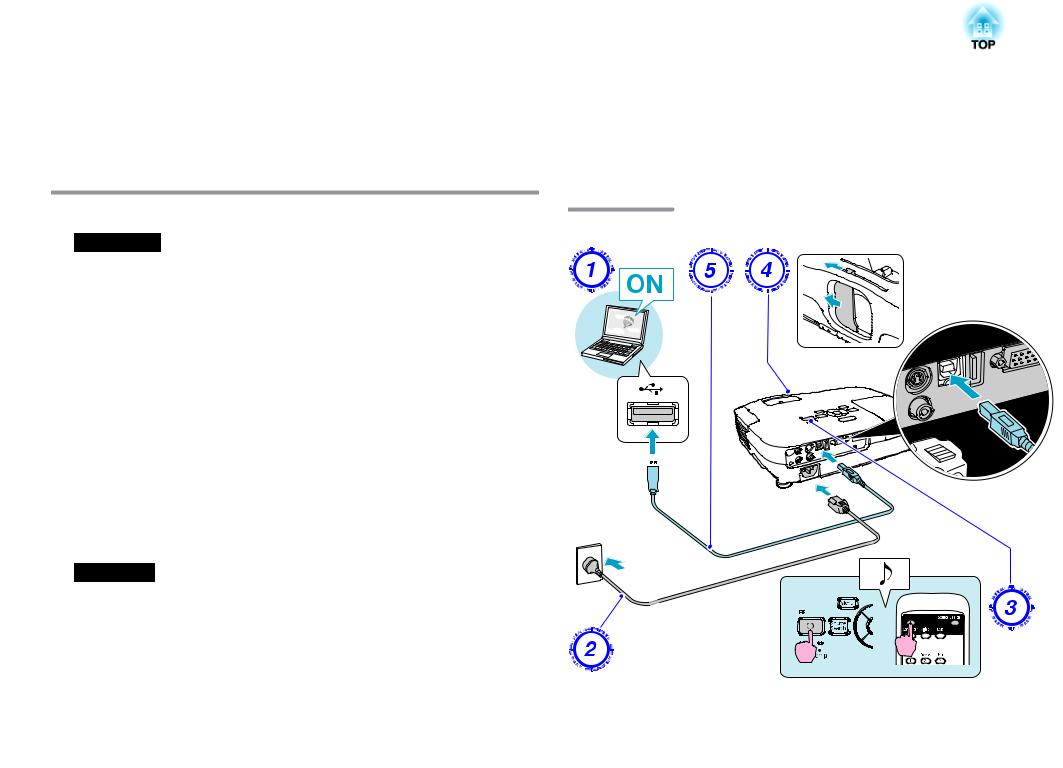
Connecting with a USB cable and Projecting (USB Display) |
|
18 |
|
|
|
By using a USB cable to connect the projector to a computer you can project images from the computer. This function is called USB Display. Simply by connecting via a USB cable, images from the computer can be displayed.
Hard Disk |
20MB or more |
Free space |
|
|
|
Display |
Resolution greater than 640x480 and lower than 1680x1200 |
|
Display color in 16-bit color or greater |
|
|
System Requirements
Connecting
For Windows
OS* |
Windows 2000 Service Pack4 |
|
|
|
Windows XP Service Pack2 or later |
|
|
|
Windows Vista |
|
|
|
Windows Vista Service Pack1 or later |
|
|
|
Windows 7 |
|
|
|
|
|
|
CPU |
Mobile Pentium III 1.2 GHz or faster |
|
|
|
Recommended: Pentium M 1.6 GHz or faster |
|
|
|
|
|
|
Amount of |
256MB or more |
|
|
Memory |
Recommended: 512 MB or more |
|
|
|
|
|
|
Hard Disk |
20MB or more |
|
|
Free space |
|
|
|
|
|
|
|
|
|
|
|
Display |
Resolution greater than 640x480 and lower than 1600x1200 |
|
|
|
|
||
|
Display color in 16-bit color or greater |
|
|
|
|
|
|
*Only 32 bit is supported.
For Mac OS
OS |
Mac OS X 10.5.1 or later |
|
|
|
|
|
|
|
|
|
|
||
|
Mac OS X 10.6.x |
|
|
|
|
|
|
|
|
|
|
|
|
|
|
|
|
|
|
|
CPU |
Power PC G4 1 GHz or faster |
|
|
|
|
|
|
Recommended: Intel Core Duo 1.83 GHz or faster |
|
|
|
|
|
|
|
|
|
|
|
|
|
|
|
|
|
|
|
Amount of |
512MB or more |
|
|
|
|
|
Memory |
|
|
|
|
|
|
|
|
|
|
|
|
|

Connecting with a USB cable and Projecting (USB Display) |
|
19 |
|
|
|
Procedure
A B C D E
Turn the computer on.
Connect to the power cable (supplied).
Turn the projector on.
Open the A/V mute slide.
Connect to the USB cable.
To output audio from the projector's speaker, connect an audio cable (commercially available) to the Audio Input Port.
s "Connecting for the first time" p.20
s "From the second time" p.21
Attention
Connect the projector directly to the computer and not via a USB hub.
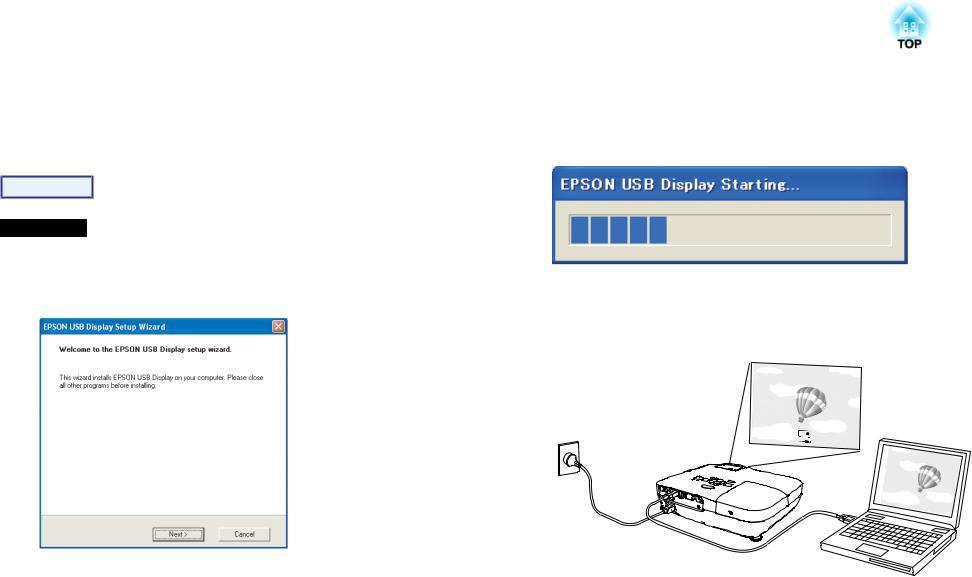
Connecting with a USB cable and Projecting (USB Display) |
|
20 |
|
|
|
Connecting for the first time
When connecting for the first time, you need to install the driver. The installation procedure differs for Windows and Mac OS.
Procedure
For Windows
A Driver installation starts automatically.
When you are using a Windows 2000 computer, double-click My Computer - EPSON_PJ_UD - EMP_UDSE.EXE, on your computer.
When using a computer running Windows 2000 under user authority, a Windows error message is displayed during installation and you may not be able to install the software. In this case, try updating Windows to the latest version, restart, and then try to connect again.
For more details, contact the nearest address provided in the Support and Service Guide. s Epson Projector Contact List
B Click "Agree".
If the driver is not installed, you cannot start USB Display. Select Agree to install the driver. If you want to cancel installation, click
Disagree.
C Computer images are projected.
It may take a while before computer images are projected. Until computer images are projected, leave the equipment as it is and do not disconnect the USB cable or turn off the power to the projector.
D When you are finished, disconnect the USB cable.
The projector can be disconnected simply by disconnecting the USB cable. There is no need to use the Safely Remove Hardware feature in Windows.
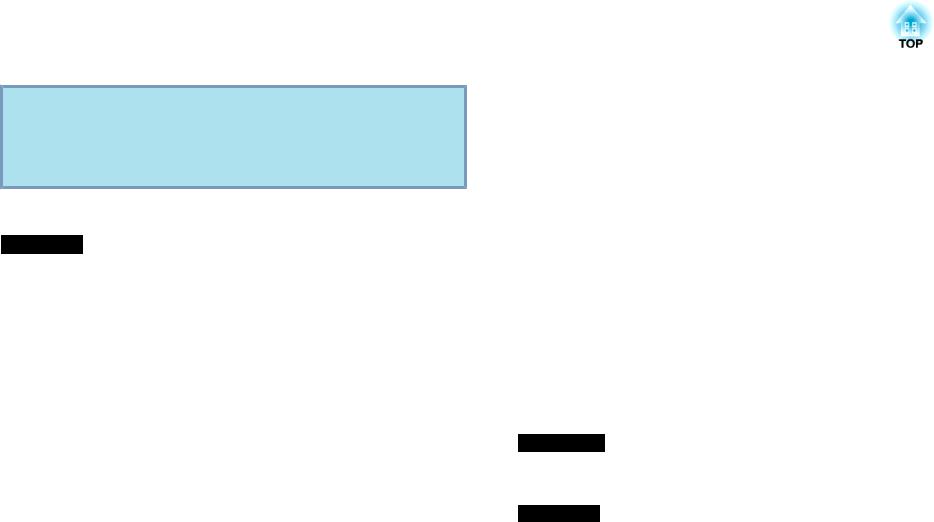
Connecting with a USB cable and Projecting (USB Display) |
|
21 |
|
|
|
q |
• If |
it is not installed automatically, double-click My Computer - |
||
EPSON_PJ_UD - EMP_UDSE.EXE, on |
your |
computer. |
||
|
• If |
nothing is projected for some reason, |
click |
All Programs - |
EPSON Projector - EPSON USB Display - EPSON USB Display Vx.x, on your computer.
See s "From the second time" p.21 when connecting the next time.
For Mac OS
A The Setup folder for USB Display is displayed in Finder.
B Double-click the "USB Display Installer" icon.
Enter the Administrator password to start installation.
C Follow the on-screen instructions to install.
D When the License Agreement screen is displayed, select
"Agree".
If Agree is not selected, you cannot start USB Display. If you want to cancel projection, click Disagree.
When installation is complete, the USB Display icon is displayed in the Dock and on the menu bar.
E Computer images are projected.
It may take a while before computer images are projected. Until computer images are projected, leave the equipment as it is and do not disconnect the USB cable or turn off the power to the projector.
F When you are finished, disconnect the USB cable.
Click the menu bar icon or the Dock icon and execute Disconnect from the menu displayed, and then remove the USB cable.
q |
• If the Setup folder for USB Display is not automatically displayed in |
Finder, double-click EPSON PJ_UD - USB Display Installer on the |
|
|
computer. |
|
• If nothing is projected for some reason, click the USB Display icon |
|
in the Dock. |
|
• If there is no USB Display icon in the Dock, run USB Display from |
|
the Applications folder. |
|
• If you select Quit from the Dock icon menu, USB Display does not |
|
start automatically the next time the USB cable is connected. |
|
|
From the second time
Computer images are projected.
It may take a while before computer images are projected. Please wait.
Uninstalling
For Windows
Open Control Panel - Add/Remove Programs - and uninstall EPSON USB Display.
For Mac OS
Run USB Display UnInstaller from the Tool folder in the Application folder.
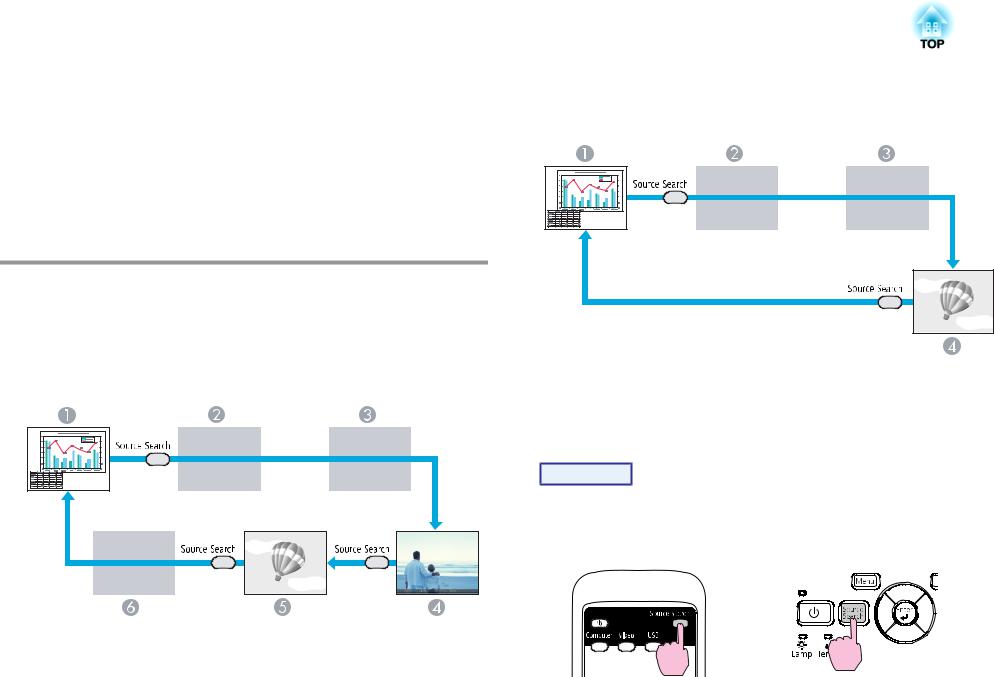
Changing the Projected Image |
|
22 |
|
|
|
You can change the projected image in the following two ways.
•Changing by Source Search
The projector automatically detects signals being input from connected equipment, and the image being input from the equipment is projected.
•Changing directly to the target image
You can use the Remote Control buttons to change to the target input port.
F USB
EB-S10/W9/X9/S9/X92/S92
Automatically Detect Input Signal and Change the Projected Image (Source Search)
You can project the target image quickly as input ports with no image signal being input are ignored when you change by pressing the [Source Search] button.
EB-W10/X10
AComputer
BS-Video
CVideo
DUSB Display
Procedure |
When your video equipment is connected, start playback before beginning this operation.
Using the Remote Control |
Using the Control panel |
A Computer
B S-Video
CVideo
DHDMI
EUSB Display

Changing the Projected Image |
|
23 |
|
|
|
When two or more pieces of equipment are connected, press the [Source Search] button until the target image is projected.
q The following screen showing the status of image signals is displayed when only the image that the projector is currently displaying is available, or when no image signal can be found. You can select the input port where the equipment you want to use is connected. If no operation is performed after about 10 seconds, the screen closes.
Example: EB-W10/X10
Switch to the target image by Remote Control
You can change directly to the target image by pressing the following buttons on the Remote Control.
Remote Control
AChanges to images from the Computer input port.
BEach time the button is pressed, the image cycles through the Video, S- Video, and HDMI (EB-W10/X10 only) input ports.
CEach time the button is pressed, the image changes between USB Display and Slideshow (EB-W10/X10 only).
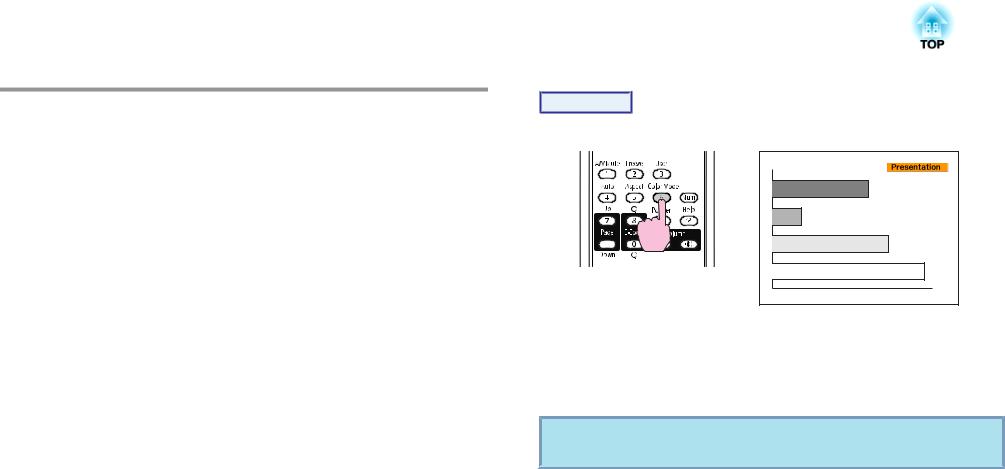
Functions for Enhancing Projection |
|
24 |
|
|
|
Selecting the Projection Quality (Selecting Color
Mode)
You can easily obtain the optimum image quality simply by selecting the setting that best corresponds to your surroundings when projecting. The brightness of the image varies depending on the mode selected.
|
|
Mode |
Application |
|
Dynamic |
Ideal for use in a bright room. This is the brightest |
|
|
|
|
mode, and reproduces shadow tones well. |
|
|
|
|
|
Presentation |
Ideal for making presentations using color materials |
|
|
|
|
in a bright room. |
|
|
|
|
|
Theatre |
Ideal for watching films in a dark room. Gives |
|
|
|
|
images a natural tone. |
|
|
|
|
|
Photo*1 |
Ideal for projecting still pictures, such as photos, in |
|
|
|
|
a bright room. The images are vivid and brought |
|
|
|
into contrast. |
|
|
|
|
|
Sports*2 |
Ideal for watching TV programmes in a bright |
|
|
|
|
room. The images are vivid and brought to life. |
|
|
|
|
|
sRGBg |
Ideal for images that conform to the sRGB color |
|
|
|
|
standard. |
|
|
|
|
|
Blackboard |
Even if you are projecting onto a Blackboard |
|
|
|
|
(greenboard), this setting gives your images a |
|
|
|
natural tint, just like when projecting onto a screen. |
|
|
|
|
|
Whiteboard |
Ideal for making presentations using the whiteboard. |
|
|
|
|
|
*1 Selectable only when RGB signal is input or the Source is set to USB Display or USB (EB-W10/X10 only).
*2 Selectable only when component video, S-video, or composite video images are input.
Procedure
Remote Control
Each time you press the button, the Color Mode name is displayed on the screen and the Color Mode changes.
If you press the button while the Color Mode name is displayed on the screen, it changes to the next Color Mode.
q The color mode can also be set using Color Mode in the Image menu from the Configuration Menu. s p.49
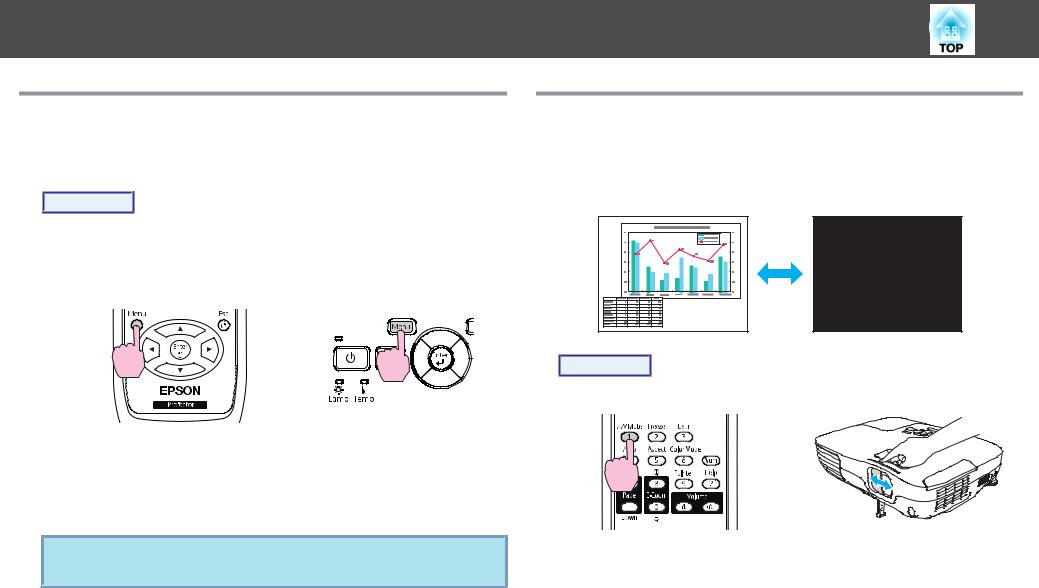
Functions for Enhancing Projection |
25 |
Setting the Auto Iris
By automatically setting the luminance according to the brightness of the displayed image, it lets you enjoy deep and rich images.
Procedure
A Press the [Menu] button and select Image - Auto Iris from the Configuration Menu. s "Using the Configuration Menu" p.48
Using the Remote Control |
Using the Control panel |
B Select "On".
The setting is stored for each Color Mode.
C Press the [Menu] button to close the Configuration Menu.
q Auto Iris can be set only when the Color Mode is Dynamic or
Theatre.
Hiding the Image and Sound Temporarily (A/V
Mute)
You can use this when you want to focus the audience's attention on what you are saying, or if you do not want to show details such as when you are changing between files during presentations from a computer.
Procedure
Remote Control |
Body |
Each time you press the button, or open/close the lens cover A/V Mute turns on or off.
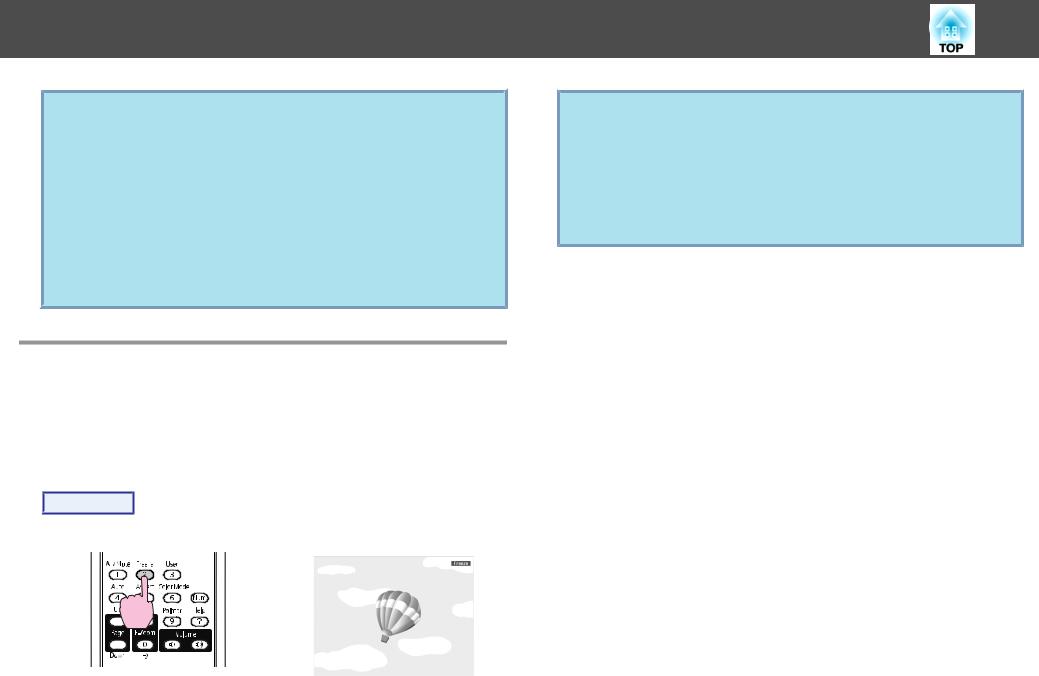
Functions for Enhancing Projection
q |
• If you use this function when projecting moving images, the images |
||
and sound continue |
to be |
played back by the source, and you |
|
|
cannot return to the |
point |
where A/V Mute was activated. |
•When activated from the remote control, you can choose to display Black, Blue, or Logo as the A/V Mute display using the Extended - Display - A/V Mute setting from the Configuration menu.
s p.53
•When the A/V mute slide is closed for approximately 30 minutes, Lens Cover Timer activates and the power is automatically turned off. If you do not want Lens Cover Timer to activate, change the
Lens Cover Timer setting to Off from Operation in the Extended menu. s p.53
Freezing the Image (Freeze)
When Freeze is activated on moving images, the frozen image continues to project on the screen, so you can project a moving image one frame at a time like a still photo. Also, you can perform operations such as changing between files during presentations from a computer without projecting any images if the Freeze function is activated beforehand.
Procedure
Remote Control
26
q • Audio does not stop.
•The image source continues to play back the moving images even while the screen is frozen, and so it is not possible to resume
projection from the point where it was paused.
•If the [Freeze] button is pressed while the Configuration Menu or a Help screen is displayed, the menu or Help screen being displayed is cleared.
•Freeze still works while E-Zoom is being used.
Each time you press the button, Freeze turns on or off.
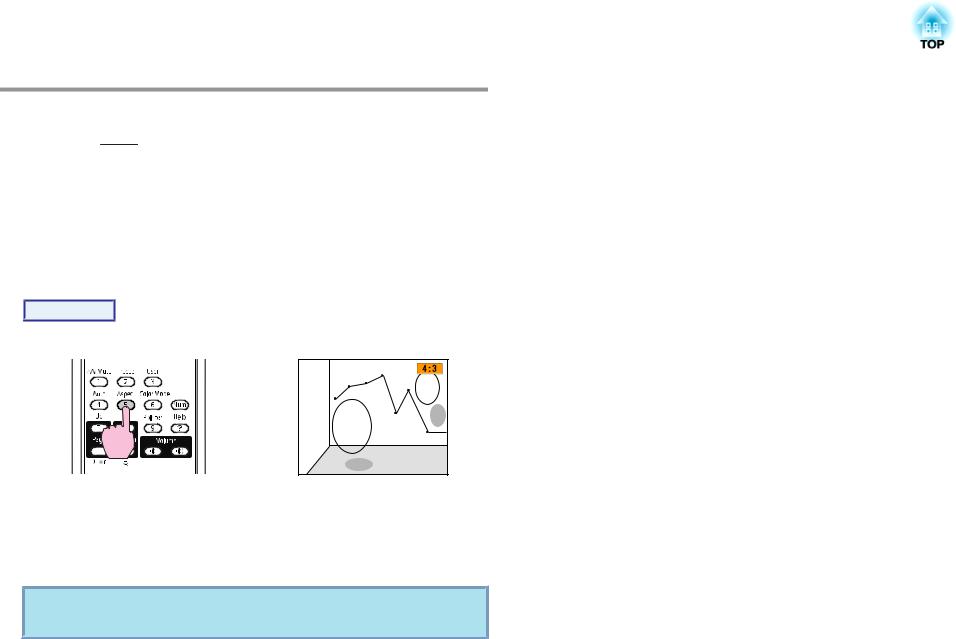
Functions for Enhancing Projection |
|
27 |
|
|
|
Changing the Aspect Ratio
Change the aspect ratiog when video equipment is connected so that images that have been recorded in digital video or onto DVDs can be viewed in 16:9 wide-screen format. Change the aspect ratio when projecting computer images at full size.
The changing methods and the types of Aspect Mode are as follows.
Changing methods
Procedure
Remote Control
Each time you press the button, the Aspect Mode name is displayed on the screen and the aspect ratio changes.
If you press the button while the Aspect Mode name is displayed on the screen, it changes to the next Aspect Mode.
q The Aspect Mode can also be set using Aspect in the Signal menu from the Configuration Menu. s p.50
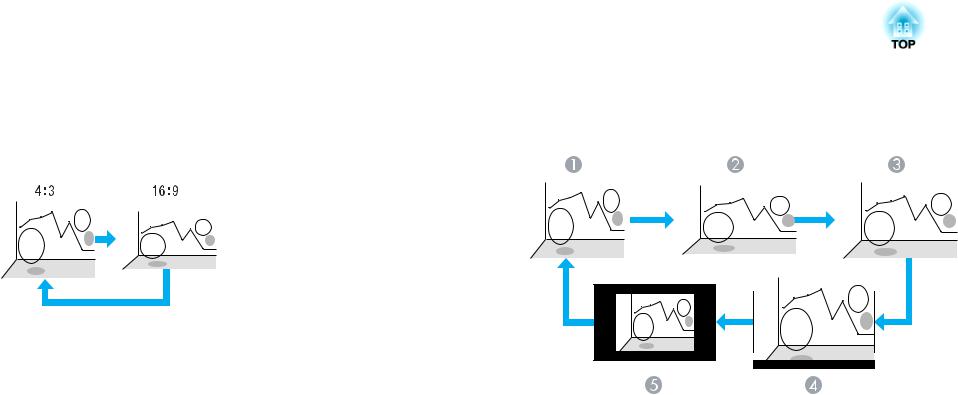
Functions for Enhancing Projection |
|
28 |
|
|
|
Changing the aspect ratio for video equipment images |
EB-W10/W9 |
||||||||||||||
|
|
|
|
|
Each time the button is pressed, it changes in the order Normal*, 16:9, |
||||||||||
EB-X10/S10/X9/S9/X92/S92 |
Full, Zoom, and Native. |
||||||||||||||
Each time you press the button, it switches between 4:3 and |
16:9. |
|
|
|
|
|
|
|
|
|
|
||||
|
|
|
|
|
|
|
|
|
|
|
|
|
|
|
|
|
|
|
|
|
|
|
|
|
|
|
|
|
|
|
|
|
|
|
|
|
|
|
|
|
|
|
|
|
|
|
|
|
|
|
|
|
|
|
|
|
|
|
|
|
|
|
|
|
|
|
|
|
|
|
|
|
|
|
|
|
|
|
|
|
|
|
|
|
|
|
|
|
|
|
|
|
|
|
|
|
|
|
|
|
|
|
|
|
|
|
|
|
|
|
|
When a signal is input from the HDMI port, it changes in the order Auto, 4:3, and 16:9. When Auto is set, it displays in an appropriate aspect ratio based on information from the input signal.(EB-X10 only)
A Normal*
B 16:9
C Full
D Zoom
E Native
* When a signal is input from the HDMI port, Auto is displayed. When Auto is selected, it displays in an appropriate aspect ratio based on information from the input signal.(EB-W10 only)
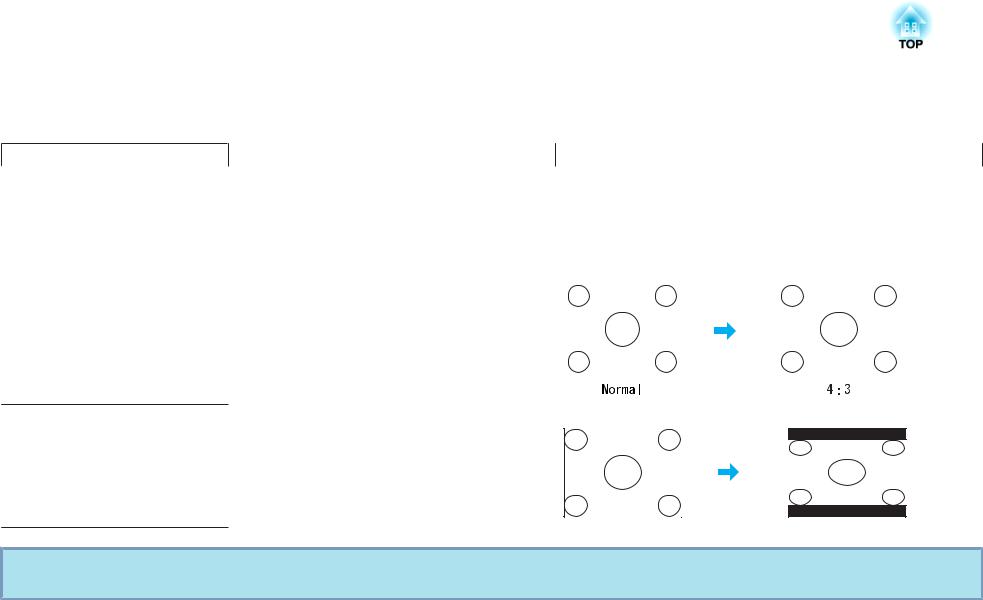
Functions for Enhancing Projection |
|
29 |
|
|
|
Changing the aspect ratio for computer images (EB-X10/S10/X9/S9/X92/S92)
When projecting images from the computer, you can change the aspect ratio as follows.
Aspect Mode |
Operation |
|
|
|
|
Projection example |
||
Normal |
Projects to the full projection size retaining the aspect ratio of |
|
|
|
|
|
|
|
Displayed when the source is a computer. |
the input image. |
|
|
|
|
|
|
|
|
|
|
|
|
|
|
|
|
Auto (EB-X10 only) |
Projects in an appropriate aspect ratio based on information |
|
|
|
|
|
|
|
Displayed only when the source is |
from the signal being input. |
|
|
|
|
|
|
|
HDMI. |
|
|
|
|
|
|
|
|
|
|
|
||||||
4:3 |
Projects to the full projection size at an aspect ratio of 4:3. |
When a 1280x1024 signal is input |
||||||
|
This is ideal for when you want to project images at an aspect |
|
|
|
|
|
|
|
|
|
|
|
|
|
|
|
|
|
ratio of 5:4 (1280 x 1024) to the full projection size. |
|
|
|
|
|
|
|
|
|
|
|
|
|
|
|
|
16:9 |
Projects at a 16:9 aspect ratio. This is ideal for projecting at When a 1280x1024 signal is input |
|
full screen size when using a 16:9 screen. |
q If parts of the image are missing, set Wide or Normal in Resolution from the Configuration Menu depending on the size of the computer panel. s p.50
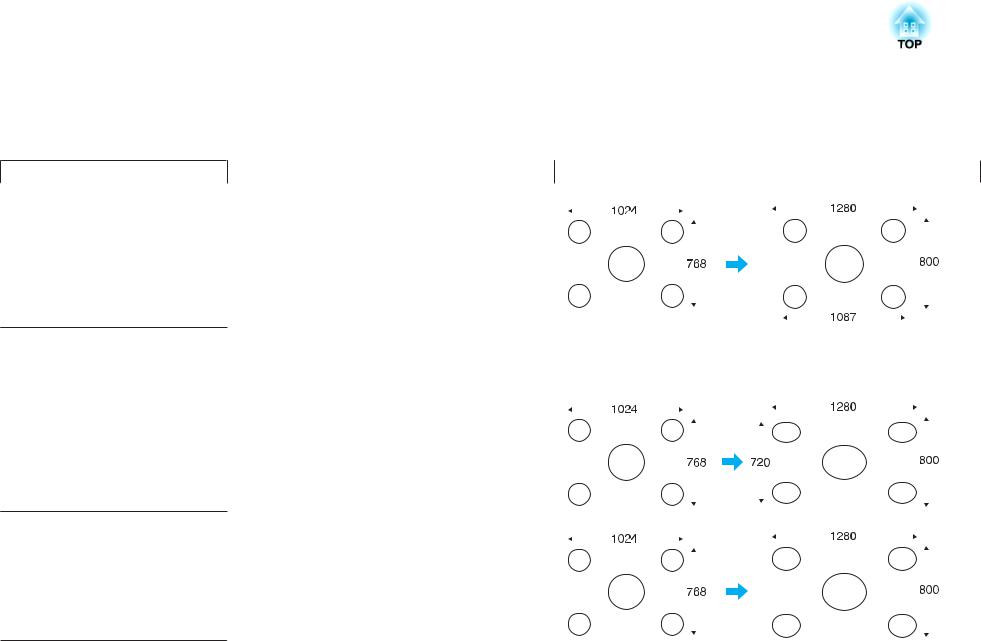
Functions for Enhancing Projection |
|
30 |
|
|
|
Changing the aspect ratio for computer images (EB-W10/W9)
You can change the aspect ratio as follows. For EB-W10/W9, the projection size is 1280 x 800 dots (aspect ratio 16:10) due to WXGA panel resolution. When projecting onto 16:9 screens, set the Aspect Mode to 16:9.
Aspect Mode |
Operation |
|
|
|
|
|
|
|
|
|
|
Projection example |
||||||||||||||
Normal |
Projects to the full projection size retaining the aspect ratio of |
When a 1024x768 signal is input |
||||||||||||||||||||||||
|
the input image. |
|
|
|
|
|
|
|
|
|
|
|
|
|
|
|
|
|
|
|
|
|
|
|
|
|
|
|
|
|
|
|
|
|
|
|
|
|
|
|
|
|
|
|
|
|
|
|
|
|
|
|
|
|
|
|
|
|
|
|
|
|
|
|
|
|
|
|
|
|
|
|
|
|
|
|
|
|
|
|
|
|
|
|
|
|
|
|
|
|
|
|
|
|
|
|
|
|
|
|
|
|
|
|
|
|
|
|
|
|
|
|
|
|
|
|
|
|
|
|
|
|
|
|
|
|
|
|
|
|
|
|
|
|
|
|
|
|
|
|
|
|
|
|
|
|
|
|
|
|
|
|
|
|
|
|
|
|
|
|
|
|
|
|
|
|
|
|
|
|
|
|
|
|
|
|
|
|
|
|
|
|
|
|
|
|
|
|
|
|
|
|
|
|
|
|
|
|
|
|
|
|
|
|
|
|
|
|
|
|
|
|
|
|
|
Auto (EB-W10 only) |
Projects in an appropriate aspect ratio based on information |
|
|
|
|
|
|
|
|
|
|
|||||||||||||||
Displayed only when the source is |
from the input signal. |
|
|
|
|
|
|
|
|
|
|
|||||||||||||||
HDMI. |
|
|
|
|
|
|
|
|
|
|
|
|
|
|
|
|
|
|
|
|
|
|
|
|
|
|
|
|
|
|
|
|
|
|
|
|
|
|
|||||||||||||||
16:9 |
Projects to the full projection size at an aspect ratio of 16:9. When a 1024x768 signal is input |
|
|
|
|
|
|
|
|
|
|
|||||||||||||||
|
|
|
|
|
|
|
|
|
|
|
|
|
|
|
|
|
|
|
|
|
|
|
|
|
|
|
|
|
|
|
|
|
|
|
|
|
|
|
|
|
|
|
|
|
|
|
|
|
|
|
|
|
|
|
|
|
|
|
|
|
|
|
|
|
|
|
|
|
|
|
|
|
|
|
|
|
|
|
|
|
|
|
|
|
|
|
|
|
|
|
|
|
|
|
|
|
|
|
|
|
|
|
|
|
|
|
|
|
|
|
|
|
|
|
|
|
|
|
|
|
|
|
|
|
|
|
|
|
|
|
|
|
|
|
|
|
|
|
|
|
|
|
|
|
|
|
|
|
|
|
|
|
|
|
|
|
|
|
|
|
|
|
|
|
|
|
|
|
|
|
|
|
|
|
|
|
|
|
|
|
|
|
|
|
|
|
|
|
Full |
Project at full size. |
When a 1024x768 signal is input |
|
|
|
|
|
|
|
||||||||||||
|
|
|
|
|
|
|
|
|
|
|
|
|
|
|
|
|
|
|
|
|
|
|
|
|
|
|
|
|
|
|
|
|
|
|
|
|
|
|
|
|
|
|
|
|
|
|
|
|
|
|
|
|
|
|
|
|
|
|
|
|
|
|
|
|
|
|
|
|
|
|
|
|
|
|
|
|
|
|
|
|
|
|
|
|
|
|
|
|
|
|
|
|
|
|
|
|
|
|
|
|
|
|
|
|
|
|
|
|
|
|
|
|
|
|
|
|
|
|
|
|
|
|
|
|
|
|
|
|
|
|
|
|
|
|
|
|
|
|
|
|
|
|
|
|
|
|
|
|
|
|
|
|
|
|
|
|
|
|
|
|
|
|
|
|
|
|
|
|
|
|
|
|
|
|
|
